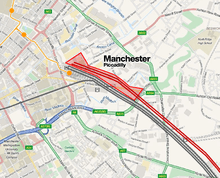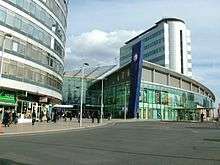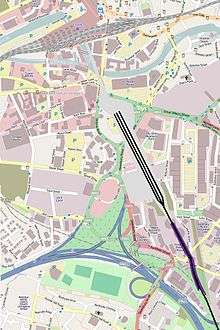High Speed 2 Phase Two
| High Speed 2 - Phase Two | |
|---|---|
|
The Phase Two route, highlighted in red, consists of two lines to Manchester and Leeds | |
| Overview | |
| Type | High-speed railway |
| System | National Rail |
| Status | Planning stage |
| Locale | Midlands, North West, Yorkshire |
| Termini |
Birmingham Curzon Street Manchester Piccadilly Leeds New Lane |
| Stations |
Manchester spur: Crewe Manchester Airport Manchester Piccadilly Leeds spur: Toton Sidings Sheffield Meadowhall Leeds New Lane |
| Operation | |
| Opened | 2032-33 (planned) |
| Depot(s) | Golborne |
| Rolling stock | To be decided |
| Technical | |
| Number of tracks | Double track throughout |
| Track gauge | 1,435 mm (4 ft 8 1⁄2 in) standard gauge |
| Loading gauge | GC |
| Electrification | 25 kV AC overhead |
| Operating speed | Up to 250 mph (400 km/h)[1] |
High Speed 2 | ||||||||||||||||||||||||||||||||||||||||||||||||||||||||||||||||||||||||||||||||||||||||||||||||||||||||||||||||||||||||||||||||||||||||||||||||||||||||||||||||||||||||||||||||||||||||||||||||||||||||||||||||||||||||||||||||||||||||||||||||||||||||||||||||||||||||||||||||||||||||||||||||||||||
|---|---|---|---|---|---|---|---|---|---|---|---|---|---|---|---|---|---|---|---|---|---|---|---|---|---|---|---|---|---|---|---|---|---|---|---|---|---|---|---|---|---|---|---|---|---|---|---|---|---|---|---|---|---|---|---|---|---|---|---|---|---|---|---|---|---|---|---|---|---|---|---|---|---|---|---|---|---|---|---|---|---|---|---|---|---|---|---|---|---|---|---|---|---|---|---|---|---|---|---|---|---|---|---|---|---|---|---|---|---|---|---|---|---|---|---|---|---|---|---|---|---|---|---|---|---|---|---|---|---|---|---|---|---|---|---|---|---|---|---|---|---|---|---|---|---|---|---|---|---|---|---|---|---|---|---|---|---|---|---|---|---|---|---|---|---|---|---|---|---|---|---|---|---|---|---|---|---|---|---|---|---|---|---|---|---|---|---|---|---|---|---|---|---|---|---|---|---|---|---|---|---|---|---|---|---|---|---|---|---|---|---|---|---|---|---|---|---|---|---|---|---|---|---|---|---|---|---|---|---|---|---|---|---|---|---|---|---|---|---|---|---|---|---|---|---|---|---|---|---|---|---|---|---|---|---|---|---|---|---|---|---|---|---|---|---|---|---|---|---|---|---|---|---|---|---|---|---|---|---|---|---|---|---|---|---|---|---|---|---|---|---|---|---|---|
Legend | ||||||||||||||||||||||||||||||||||||||||||||||||||||||||||||||||||||||||||||||||||||||||||||||||||||||||||||||||||||||||||||||||||||||||||||||||||||||||||||||||||||||||||||||||||||||||||||||||||||||||||||||||||||||||||||||||||||||||||||||||||||||||||||||||||||||||||||||||||||||||||||||||||||||
| ||||||||||||||||||||||||||||||||||||||||||||||||||||||||||||||||||||||||||||||||||||||||||||||||||||||||||||||||||||||||||||||||||||||||||||||||||||||||||||||||||||||||||||||||||||||||||||||||||||||||||||||||||||||||||||||||||||||||||||||||||||||||||||||||||||||||||||||||||||||||||||||||||||||
| ||||||||||||||||||||||||||||||||||||||||||||||||||||||||||||||||||||||||||||||||||||||||||||||||||||||||||||||||||||||||||||||||||||||||||||||||||||||||||||||||||||||||||||||||||||||||||||||||||||||||||||||||||||||||||||||||||||||||||||||||||||||||||||||||||||||||||||||||||||||||||||||||||||||
High Speed 2 is a planned high-speed railway line connecting the city centres of Birmingham, Manchester and Leeds. The railway is to be delivered in two phases. The first phase linking London and Birmingham, the second linking Birmingham with Manchester and Leeds. Phase Two is planned for completion in 2032–33. Phase two is split into two sub-phases, phase 2a and phase 2b. Phase 2b is the section from Birmingham to Crewe with phase 2b the remainder of phase 2.
The concept of HS2 was that all major cities covered would have a city centre station. Liverpool along with London, Birmingham, Manchester and Leeds was envisaged to have a city centre HS2 station. The preliminary route for Phase Two was announced on 28 January 2013.[2] It is envisaged construction on Phase Two will start in 2022 with completion by 2032.
Background
Manchester route
Manchester sits on a spur of the mixed use West Coast Main Line (WCML), one of the busiest rail routes in Europe from Scotland, through the populated regions of North West England, the Midlands and onto South East England. Demand from Manchester Piccadilly to London Euston grew 70% between 1999 and 2010 with the WCML accounting for 43% of all rail freight traffic in the United Kingdom.[3] Network Rail released a study in 2011 stating that capacity on the West Coast Main Line would be almost full if rail usage continues to grow.
A plan to upgrade the West Coast Main Line was undertaken between 1996 and 2008 by Railtrack and continued under Network Rail from 2001. The £2.2 billion plan was to originally upgrade the speed of the existing tilting Pendolino trains from the maximum speed of 110 mph to 155 mph, reducing journey times between Manchester & Liverpool and London to approximately 1 hour 45 minutes. The upgrade costs spiralled to over £8 billion, not delivering the planned 155 mph speed and 1-hour-45-minute journey between both cities.[4] Central to the modernisation plan was implementing moving block signalling; however, this had only been successful on metro lines and light rail systems, and the implementation on a heavily used line such as the West Coast Main Line failed.
Birmingham to Manchester
Crewe
Birmingham to Crewe is phase 2a, which is propesed to be built before phase 2b. HS2 will pass through Staffordshire and Cheshire, in a tunnel under Crewe station but not stopping at Crewe railway station.[5] However, the HS2 line will be linked to the West Coast Main Line via a grade-separated junction just south of Crewe, enabling "classic compatible" trains exiting the high-speed line to call at the existing Crewe station.[6][7]
High-speed Crewe hub
David Higgins the chairman of HS2 Ltd proposed an addition to phase two, a high-speed hub at Crewe to take advantage of and access the six classic lines radiating from the existing Crewe junction. Many more regions and cities would have overall superior journey times being accessed with a combination of HS2 and classic lines. The hub is a part of phase two, however Higgins proposes the hub and line from Birmingham to Crewe (phase 2a) to be constructed simultaneously with phase one.
Crewe is currently a major rail junction with six radiating classic lines from the junction to: Scotland/Liverpool, Birmingham/London, Chester, Shrewsbury, Stoke and Manchester. The high-speed hub is to be sited to the south of the current Crewe station. The intention is for high-speed trains to run off the northbound HS2 line into the high-speed hub and out onto a number of classic lines without passing though the bottleneck of the existing Crewe station, keeping line-speeds as fast as possible. A new high-speed rail station is proposed as a part of the hub. [8][9][10]
Manchester Airport

A Manchester Interchange station is planned to serve Manchester Airport on the southern boundary of Manchester. It will be located next to Junction 5 of the M56 motorway on the northern side of the airport and approximately 1.5 miles (2.4 km) north-west of Manchester Airport railway station.[5][11] Manchester Airport is the busiest airport offering more destinations than any other British airport outside of the London region. An airport station was recommended by local authorities during the consultation stage.[12][13] The government agreed in January 2013 for an airport station but agreed only on the basis that private investment was involved, such as funding from the Manchester Airports Group to build the station. The average journey from London Euston to Manchester Airport would be 59 minutes.
Manchester city centre


The route will continue from the airport into Manchester city centre via a 7.5-mile (12.1 km) bored tunnel under the dense urban districts of south Manchester before surfacing at Ardwick.[14][15][16] If built, it will represent one of the major engineering feats of HS2 and will be the longest rail tunnel to be built in the United Kingdom, surpassing the 6.2-mile (10.0 km) High Speed 1 tunnel completed in 2004.[17] It is anticipated that the stretch from Rostherne in Cheshire to Ardwick will take up to 7 years to construct.[18]
The 7.6 mile twin-bore tunnel will be at an average depth of 33 metres and trains will travel at 142 mph through the tunnel. The diameter size of the tunnel is dependent on the train speed and length of the tunnel.[19] It is envisaged both tunnels will be, as an 'absolute minimum', at least 7.25 metres in diameter to accommodate the high speed trains.[20]
Up to fifteen sites were put forward including Sportcity, Pomona Island, expanding Deansgate railway station and re-configuring the disused grade-II listed Manchester Central terminal station building back into a station.[21] Three final sites made the long list: Manchester Piccadilly station, Salford Central station and a newly built station at Salford Middlewood Locks.[22] Three approaches were considered, one via the M62, one via the River Mersey and the other through south Manchester. Both Manchester and Salford City Council recommended routing High Speed 2 to Manchester Piccadilly to maximise economic potential and connectivity rather than building a new station at a greater cost and which could be isolated from existing transport links.[23]
HS2 trains will terminate at an upgraded Manchester Piccadilly station.[5] At least four new 400-metre-long (1,300 ft) platforms will be built to accommodate the new high-speed trains in addition to the two platforms which are currently planned as part of the Northern Hub proposal.[13] It is envisaged Platform 1 under the existing listed train shed will also be converted to a fifth HS2 platform to reduce cost. However at 242 metres long, it is the shortest platform at the station and falls short of the 400 metre platform required to accommodate High Speed trains.[24] The HS2 concourse will be connected to the existing concourse at Piccadilly. HS2 will reduce the average journey time from central Manchester to central London from 2 hours 8 minutes to 1 hour 8 minutes.
Birmingham to Leeds
A new station in the East Midlands is proposed, which might be a parkway station,[note 1] to serve Nottingham, Derby and Leicester.[25] The Derbyshire and Nottingham Chamber supported high-speed rail coming to the East Midlands but was concerned that a parkway station instead of centrally located city stations would result in no overall net benefit in journey times.[25] East Midlands Parkway railway station was recently constructed on the Midland Main Line south of Derby and Nottingham. HS2 would continue north to a station at Sheffield railway station in South Yorkshire (serving Sheffield and surrounding large towns), terminating in West Yorkshire in central Leeds with a new station called Leeds New Lane. This new station will link with Leeds railway station by a walkway with the possibility of moving walkways.
Toton Sidings
Chesterfield
Sheffield Midland
Leeds

HS2 will reduce the average journey time from central Leeds to London from 2 hours 20 minutes to 1 hour 28 minutes.
References
- Citations
- ↑ DfT (2010a), page 127
- ↑ "HS2: High-speed rail route phase two details announced". BBC News. 28 January 2013. Retrieved 3 February 2013.
- ↑ "Strategic Business Plan - West Coast Main Line" (PDF). Network Rail. October 2007.
- ↑ Meek, James (1 April 2004). "The £10bn Rail Crash". The Guardian. London.
- 1 2 3 Millward, David (6 January 2013). "HS2 route: Manchester and Liverpool win while Sheffield loses out". The Telegraph. Retrieved 2013-01-27.
- ↑ "Stoke-on-Trent 'ignored' under HS2 rail route plans". BBC News. 28 January 2013. Retrieved 2 February 2013.
- ↑ "Route section HSM09 plan and profile sheet 2 of 2 - drawing number HS2-MSG-WCM-ZZ-DT-RT-60902" (PDF). HS2 phase two initial preferred route plan and profile maps. DfT. January 2013. Retrieved 2 February 2013.
- ↑ http://www.cheshireeast.gov.uk/council_and_democracy/council_information/media_hub/media_releases/previous_media_releases/media_releases_march_2014/on_the_right_track.aspx
- ↑ http://stophs2.org/news/12505-change-expected-hs2-phase-2-higgins-plan
- ↑ http://www.sccci.co.uk/portal/news/769/chamber-chairman-hails-quot-a-new-beginning-for-crewe-quot/
- ↑ "Route section HSM28 plan and profile sheet 5 of 9 - drawing number HS2-MSG-MA0-ZZ-DR-RT-52805" (PDF). HS2 phase two initial preferred route plan and profile maps. DfT. January 2013. Retrieved 2 February 2013.
- ↑ "Council chiefs lobby ministers for TWO high speed rail stations". Manchester Evening News. 22 January 2013. Retrieved 2013-01-27.
- 1 2 "Manchester Airport may be high-speed rail network hub". Manchester Evening News. 13 March 2011. Retrieved 11 March 2012.
- ↑ "Options for Phase 2 of the High Speed rail network". 28 January 2013. p. 96.
- ↑ "HS2 to enter Manchester via tunnel under city". BBC News. 28 January 2013. Retrieved 2013-01-28.
- ↑ HS2 Drawings for Greater Manchester Tunnel HS2-MSG-MA0-ZZ-DR-RT-52805 and HS2-MSG-MA0-ZZ-DR-RT-52809
- ↑ "Tunnel vision". The Guardian. 27 May 2005. Retrieved 2013-01-30.
- ↑ "The HS2 Review" (PDF). HS2. 17 March 2014. p. 12. Retrieved 2014-03-17.
- ↑ "Options for Phase Two" (PDF). 28 January 2013. p. 9. Retrieved 2013-02-02.
- ↑ "HS2 Cost and Risk - Infrastructure rate comparison" (PDF). 28 January 2013. p. 24. Retrieved 2013-02-02.
- ↑ "Options for Phase 2 of the High Speed rail network". p. 110.
- ↑ "Options for High Speed Two Phase 2" (PDF). 28 January 2013. p. 120. Retrieved 2013-01-30.
- ↑ "Options for Phase 2 of the High Speed rail network". p. 120.
- ↑ "Night Trains: Manchester - Paris". Innovation with Manchester to Paris. Retrieved 2013-02-07.
- 1 2 "New 'parkway' station could be built in East Midlands". Nottingham Evening Post. 3 December 2009. Retrieved 4 January 2010.
- Notes
- ↑ In British usage, a parkway station is one with car parking, remote from the location it is intended to serve
